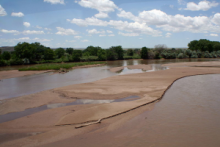Article
An area that is prone to seasonal flooding. Flood plains vary in size and usually follow lower parts of valleys through which a primary water source flows. Because of seasonal flooding, flood plains are known for their highly fertile soil deposits as well as the danger to life and property associated with flooding. In the Southwest, for example, as riverine areas, like the Rio Grande, were permanently settled, usually by European settlers, the risks of flooding to human-made improvements to the landscape, like bridges, roads, and neighborhoods, were thought to outweigh the benefits of a freely-flowing river that occasionally traveled beyond its own banks. Therefore, engineered structures, such as levees, dams, catchments, and canals, were built to attempt to regulate the flow of rivers as well as to contain flooding. This benefited those who developed permanently static life ways along rivers, but it also served as a detriment to the vitality of the ecosystems, including those of the rivers themselves, that relied on annual flooding to recharge their systems with nutrients and moisture.
"The Rio Grande River near Isleta Pueblo south of Albuquerque, NM, February 6, 2010" by Asaavedra32 is licensed under CC BY-SA.
Manuscripts
References
National Geographic Online
2015 Education: Flood Plain. http://education.nationalgeographic.com/education/encyclopedia/flood-pl…, accessed February 9, 2015.
Pueblo de Cochiti Online
N.d. Cochiti Dam and Reservoir. http://www.pueblodecochiti.org/recreation.html, accessed
February 9, 2015.

